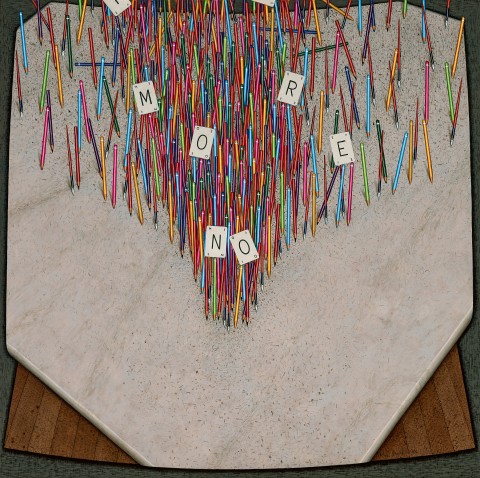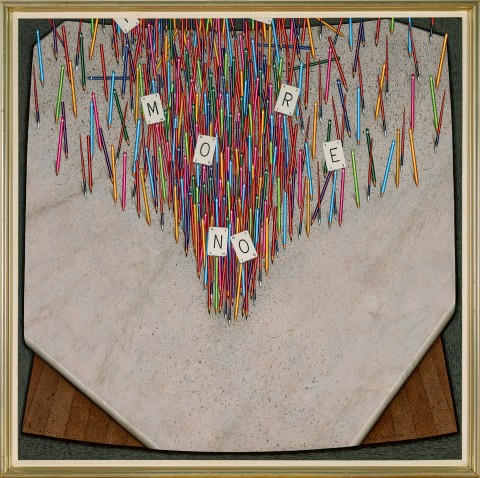NO MORE, 1984
JOHN BRACK
oil on canvas
137.0 x 137.0 cm
signed and dated lower right: John Brack 1984
Rex Irwin Art Dealer, Sydney (label attached verso)
Joan Clemenger AO and Peter Clemenger AO, Melbourne, acquired from the above in December 1996
John Brack, Tolarno Galleries, Melbourne, 21 September – 12 October 1985, cat. 6
John Brack Paintings and Drawings, DC-Art, Sydney, 19 September – 15 October 1988
John Brack Recent Paintings and Drawings, Rex Irwin Art Dealer, Sydney, 13 April – 1 May 1993
Grishin, S., The Art of John Brack, Oxford University Press, Melbourne, 1990, vol. 1, pl. 53, pp. 164, 166 (illus.), vol. 2, cat. o282, p. 37
No More, 1984, watercolour, pen and ink, 68.0 x 68.0 cm, private collection, illus. in Grishin, S., The Art of John Brack, Oxford University Press, Melbourne, 1990, vol. 2, cat. p289, p. 241
ARC262.5.8##M.jpg
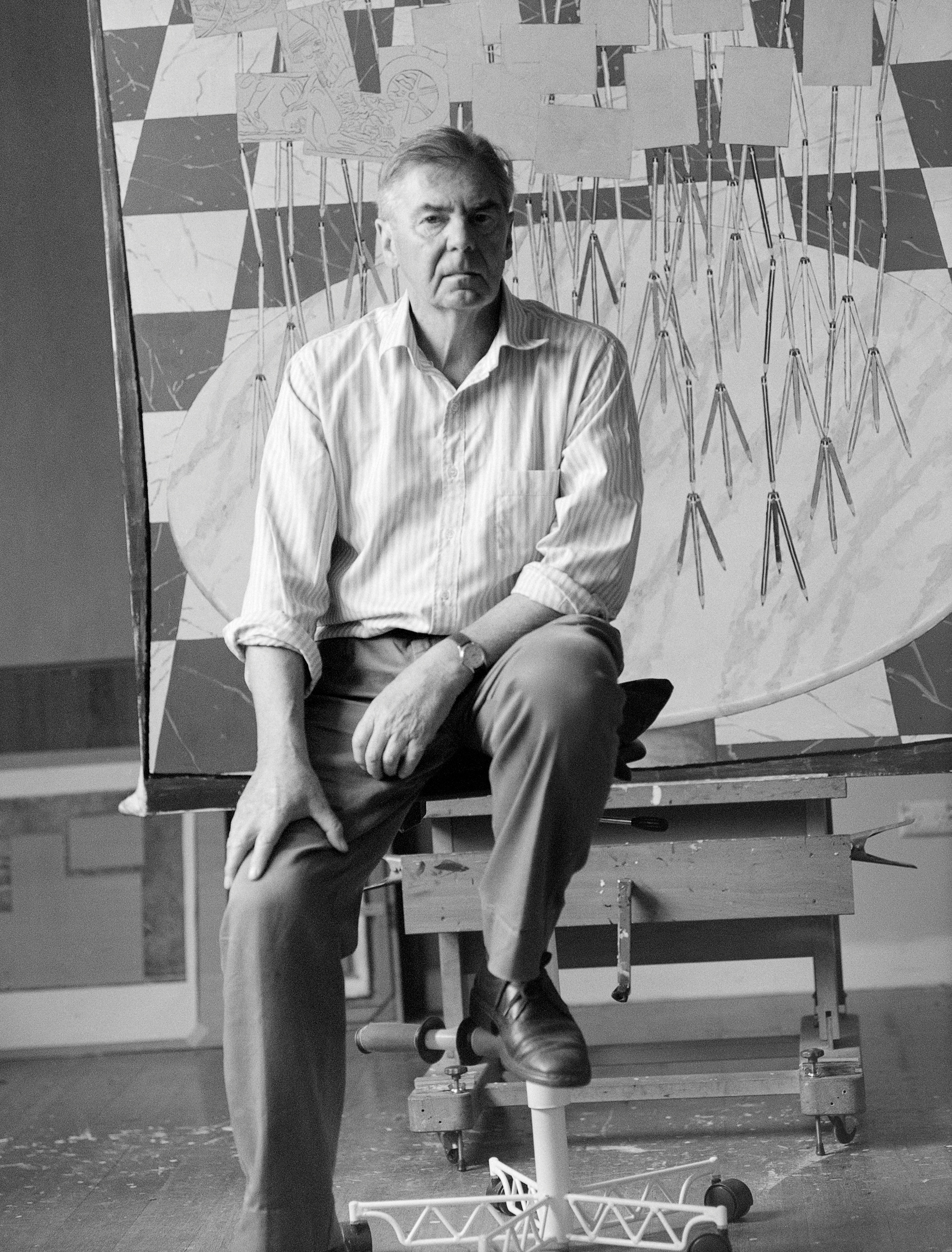
| John Brack in his Surry Hills studio, 1988 photographer: Robert Walker Art Gallery of New South Wales, Sydney © Estate of Robert Walker |
John Brack’s motivation for painting remained consistent throughout his career. In 1956, following the National Gallery of Victoria’s purchase of Collins St, 5p.m., 1955, he wrote to Eric Westbrook, the gallery’s director, explaining, ‘One either has a subject, or one has not… If I choose to paint the life I see around me, it is because I find people more interesting than things.’1 Brack satisfied this intense interest in people by finding subject matter in his immediate surroundings, the suburbs and the city of Melbourne, and now iconic paintings such as The New House, 1953 (Art Gallery of New South Wales) and The Bar, 1954 (National Gallery of Victoria) still stand as acute observations of modern Australian life. While the clothing, hairstyles, interiors and other accoutrements of mid-century suburban life imbue these paintings with a strong sense of nostalgia, it is what they reveal about human behaviour and its inevitable predictability, irrespective of the era, that is most compelling. It is this element which also provides the thematic link between Brack’s most well-known works and his later paintings.
During his tenure as head of the Melbourne National Gallery School between 1962 – 68, Brack maintained a studio in a small room behind his office, however the demands of his job and the seriousness with which he approached it left little time for making art. While no commercial exhibitions took place during these years, the positive regard in which his art was held was reflected in his inclusion in several important international exhibitions and the awarding of the inaugural Gallaher Portrait Prize in 1965 for his painting of Harold (Hal) Hattam (private collection, Melbourne). In 1967 the exhibition John Brack, Fred Williams was mounted at Albert Hall in Canberra, displaying side-by-side the art of two great friends who would eventually be counted among the most significant figures in twentieth century Australian art. Brack resigned from the Gallery School at the end of 1968 and with the promise of a monthly stipend offset against annual sales from Sydney art dealer Rudy Komon, he was able to paint full-time and constructed a purpose-built studio at home. Including paintings from the ballroom dancing series, Brack’s first commercial exhibition with Komon was held in 1970. The following year he was awarded the Travelodge Art Prize and a monograph by Ronald Millar was published, firmly cementing his place in contemporary Australian art.
Brack #3.jpg
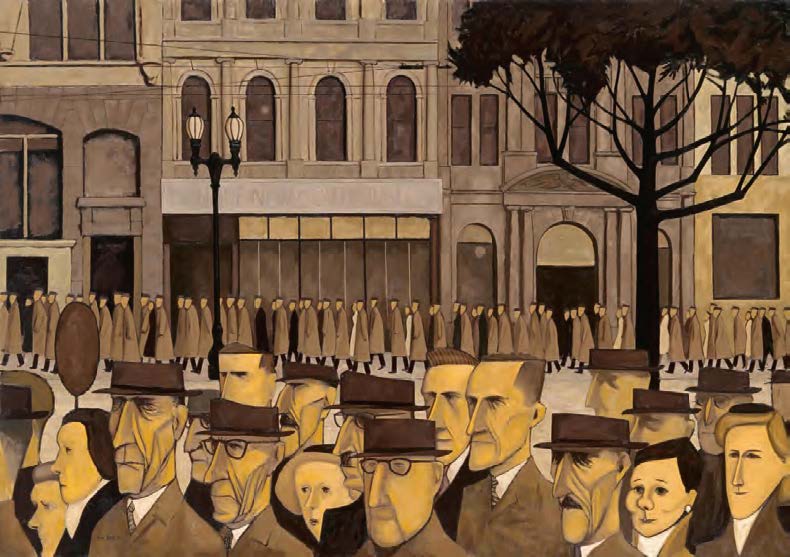
| John Brack Collins St, 5p.m., 1955 oil on canvas, 114.8 x 162.8 cm National Gallery of Victoria, Melbourne © Helen Brack |
Brack #4.jpg
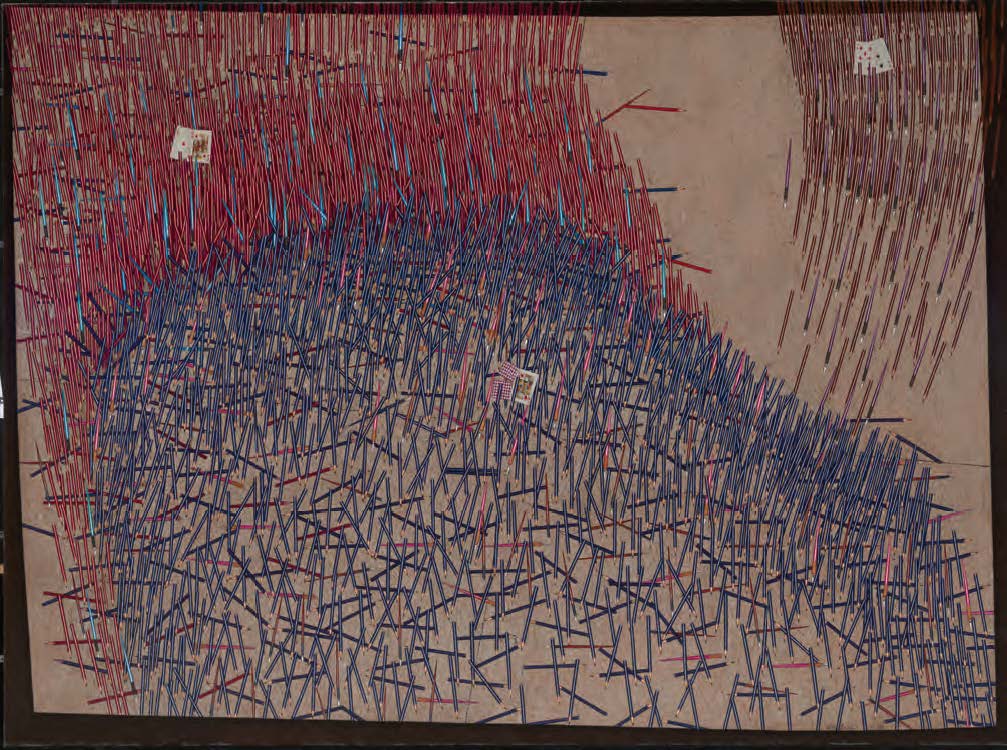
| John Brack The battle, 1981-83 oil on canvas, 203.0 x 274.0 cm National Gallery of Australia, Canberra © Helen Brack |
In late 1973 Brack and his wife, Helen, left Australia for the first time. With plans to travel in England and Europe for two months, he painstakingly planned their itinerary, ‘down to the specifics of street maps and detailing individual paintings that would form cultural targets.’2 While the experience of visiting great historical cities and seeing works of art known up until then only in reproduction left Helen buoyant, John was overwhelmed by the loss of control he felt in such unfamiliar surroundings.3 Despite this, the trip prompted a marked shift in Brack’s art and over the next few years, the human figure disappeared from his paintings almost entirely, replaced by a range of inanimate objects including museum postcards, umbrellas, pencils, playing cards and wooden artists’ manikins. Perhaps not surprisingly, when Brack showed these new paintings publicly, his audience was confounded. The social commentary that had been such a consistent feature of his work appeared to have been discarded, along with the human figure. Sandra McGrath typified the cool response of many to this new imagery, writing in the Australian newspaper that ‘Brack’s work celebrates an intellectual rather than an emotional approach to life and art. It’s a unique vision and puts him outside the mainstream of Australian art.’4
Combining this esoteric selection of objects with various domestic props to construct subtle visual metaphors, Brack found another way to express his perspective on the perennial forces of human nature, in the process transforming his view from the local to the universal.5 As Helen Brack observed, ‘What John saw in the collections of Europe gave him all the courage and consolidation and self-confidence he needed to develop the paintings of Grand Human themes that were not in his consciousness when he was young, trying to identify in the Suburbs.’6 The first paintings in this vein were exhibited under the broad title of the Unstill Life Series and combined finely rendered depictions of cutlery and postcards of antiquities which Brack had collected during his visits to museums overseas. Gleaming knives and forks often appear to hover in space while the postcards are precariously balanced on their edges and corners. These paintings, and almost all that followed, also incorporated a distinctive new element in which an irregular border frames the central image. In addition to disrupting the viewer’s right-angled perspective and drawing attention to the illusionistic nature of painting, this feature also pointed to the possibility of something else beyond the painted surface. ‘John wanted to somehow alter the balance. He knew that although the human framework calls to the right-angle and the horizontal and the vertical, you can talk about other things in the margins. The margins here are very important, because they are about the dark past, other ages. He was extremely interested in how you can use structure to say what you want to say.’7
Brack#6.jpg
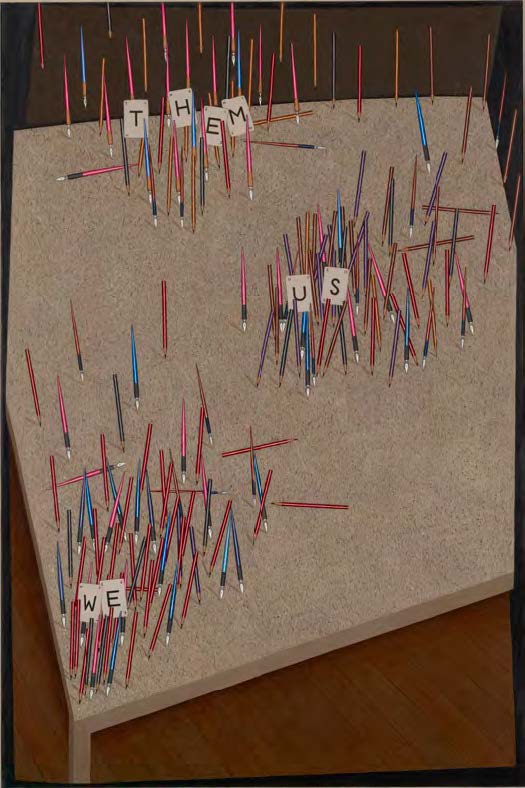
| John Brack We, us, them, 1983 oil on canvas, 183.4 x 122.4 cm National Gallery of Victoria, Melbourne © Helen Brack |
Brack#5.jpg
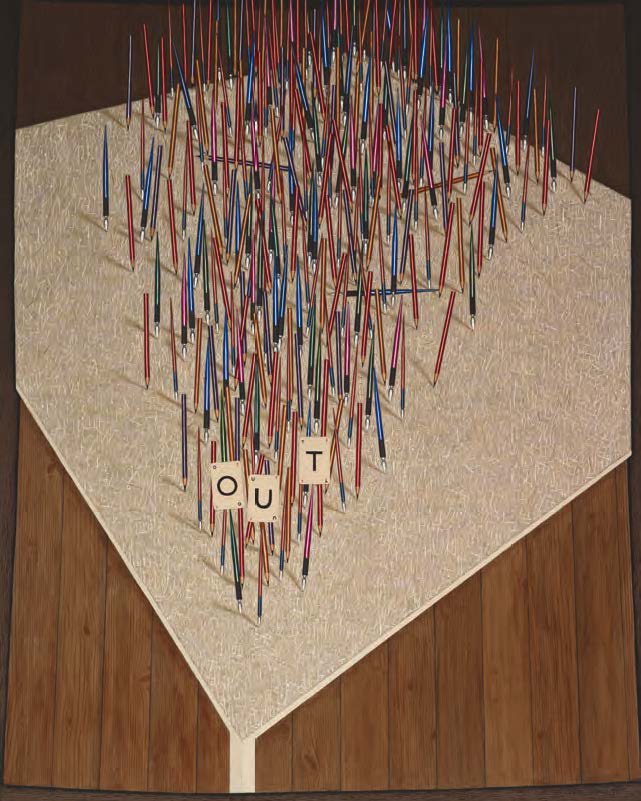
| John Brack Out, 1979 oil on canvas, 153.0 x 122.0 cm Art Gallery of New South Wales, Sydney © Helen Brack |
If the meaning behind Brack’s Unstill Life paintings remained elusive to most viewers, the works that followed, with their themes of alliance, conflict and division, should surely have made it clear. As Sasha Grishin has noted, the artist now sought ‘to express the whole complexity of social interconnections. The form needed the potential for intricacy and complexity as well as the ability to be organised with deceptive simplicity. It needed to be a thing of considerable visual beauty, yet one that could be treated in a completely impersonal way and be worked with a sense of technical detachment in order to make the picture appear silent, permanent and durable.’8 In the late 1970s umbrellas, walking sticks, pencils and pens became the active figures in Brack’s paintings and, just like people, they are seen forming into groups, declaring allegiances, breaking rank and marching in triumph. The Battle, 1981 – 83 (National Gallery of Australia) is the major work from this series and by far the largest painting within Brack’s oeuvre. Setting himself the challenge of painting what he regarded as an impossible picture, Brack set out to depict the immense scale and minute detail of a military battle – specifically the 1815 Battle of Waterloo, with the French forces in blue, surrounded by the English in red and the Prussians in brown. Recalling drawing-room conversations after dinners held at the home of his new wife’s parents decades before, where ‘those old gentlemen would start refighting the battles of World War I…[picking] up their knives and forks and salt-cellars… to represent the lines of the troops’, Brack stated, ‘My pens and pencils are the same thing.’9
The densely massed pens and pencils of No More, 1984 appear to describe a crowd, perhaps one that is marching in protest and holding aloft a banner of playing cards which spells out the title of the painting. The message is clear – No More! – but the presence of a pair of additional cards just visible at the top edge of the painting introduces a nagging, unanswered question – No More What? We see Brack’s enjoyment of colour as the crowd of yellow, pink, lime green, blue and other brightly-hued writing implements builds. Moving in from the sides and squeezing into the centre, they are oblivious to those who have fallen, and seemingly compelled on an inexorable and inevitable path that is directed by the vertiginous tilt of the table, down to the floorboards below. The crowd builds as brightly coloured writing implements move in from the sides to join its ranks, squeezing into the centre, oblivious to those who have fallen, and seemingly compelled on an inexorable and inevitable path that is directed by the vertiginous tilt of the table, down to the floorboards below. The surface of the marble table is littered with hundreds of pencil marks, both within the confines of the marching pencils and, inexplicably, on the path in front of them, suggesting that this is not the first time such a crowd has gathered on this site. The meaning of Brack’s imagery is always enigmatic, but in the context of his exploration of human nature and the recognition that generation after generation, little changes, No More might indeed represent a personal protest against what he perceived as the inevitability of human behaviour and our inability to learn from past mistakes.
Like all of Brack’s late paintings, No More is the result of intense preparation and a meticulous technique. A series of working drawings preceded the construction of an elaborate tableaux in his studio. Using a variety of furniture props, including a marble-topped table – a familiar feature in many of the late paintings carefully selected for its distinctive veined pattern – he would build a model with fishing line and tape used to suspend actual cutlery, postcards, pencils and other items in place. From this, he would make a single, highly detailed preparatory drawing on which the painting was based. Using fine brushes and glazes to minimise the appearance of brushstrokes, Brack aimed to heighten the pictorial realism in these works and in this way, to engage viewers so that they could focus on the meaning of his imagery rather than being distracted by expressive painterly bravura.10
In the late paintings Brack’s perspective expanded beyond the local to encompass the universal. As Patrick McCaughey eloquently concluded, ‘The strategy of these paintings is clear; here the still life goes beyond the observed and the daily and passes into the life of metaphor… John Brack… transforms himself from the classicist whose forms are drawn from the experience of the world to the allegorical fabulist. The still life enables him to ruminate and reflect on ideas and arguments beyond the scope of observed appearance. Brack becomes a ‘modern history painter’, able to take on the largest speculations pictorially through the humble genre of the studio still life.'11
1. Brack to Eric Westbrook, 15 April 1956, National Gallery of Victoria Artist File
2. Gott, T., A Question of Balance: John Brack 1974 – 1994, Heide Museum of Modern Art, Melbourne, 2000, p. 4
3. Ibid., pp.4 and 6
4. McGrath, S., ‘Brack’s unique vision’, The Australian, 27 December 1975, cited in Gott, ibid., p.8
5. The exceptions to this were the nudes, a subject which Brack painted throughout his career, and occasional portraits.
6. Helen Brack, cited in Gott, op. cit., p. 18
7. Ibid., p. 11
8. Grishin, S., The Art of John Brack, Oxford University Press, Melbourne, 1990, p. 140
9. Brack, cited in Grishin, ibid., p. 152
10. See Grishin, op. cit., p. 132
11. McCaughey, P., ‘The Complexity of John Brack’ in Lindsay, R., John Brack, National Gallery of Victoria, Melbourne, 1987, p. 9
KIRSTY GRANT
